CSAMT-Driven Feasibility Assessment of Beishan Underground Research Laboratory
Abstract
1. Introduction
2. Lithologies in the Study Area
- (1)
- Mesoproterozoic Gneissic Granodiorite (Pt22H)
- Medium- to fine-grained texture with augen gneiss fabric;
- Predominantly exposed in the central sector;
- Interpreted as anatectic products of ancient continental crust.
- (2)
- Caledonian Metamorphic Monzogranite (O1X)
- Exhibits porphyroblastic textures with K-feldspar megacrysts;
- Extensively distributed across northern and southwestern domains;
- Notably forms continuous outcrops along northeastern survey transects.
- (3)
- Paleoproterozoic–Archean Migmatites (AnChDyj2)
- Stromatic to nebulitic structures;
- Syn-tectonic garnet-bearing assemblages.
- (4)
- Pre-Changcheng Schist Series (AnChDyj3).
- Dominated by biotite–quartz schists with subordinate marble interbeds;
- Preserves relict marine clastic–carbonate protoliths.
3. Structure in the Study Area
3.1. Compressional and Transpressional Faults
3.2. Strike–Slip and Transtensional Faults
4. CSAMT Data Acquisition and Processing
4.1. CSAMT Raw Data
4.2. Data Processing
- (1)
- Outlier data removal: Anomalous data points were systematically excluded, primarily arising from topographic discontinuities (e.g., abrupt elevation changes at the cliff edges) or suboptimal electrode coupling during field measurements.
- (2)
- Static effect mitigation: A pre-inversion correction was implemented to address the pronounced static effect induced by shallow subsurface conductive heterogeneities. Following the methodology proposed by Torres-Verdín and Bostick (1992) [15], low-pass filtering was applied using a Hanning window (Equation (1)) to suppress high-frequency noise components, thereby enhancing the signal-to-noise ratio of the processed data.
5. Inverted Results and Interpretation
5.1. Sample Resistivity Measurement
5.2. Interpretation Results
6. Discussion
6.1. Inversion Fit Comparison at Near-Borehole Points
6.2. Site Suitability Assessment for Underground Laboratory Construction
6.2.1. High-Resistivity Zones as Indicators of Intact Rock Mass
6.2.2. Geological Suitability of Xinchang Site for HLW Geological Disposal
7. Conclusions
Author Contributions
Funding
Data Availability Statement
Conflicts of Interest
References
- Bartel, L.C. Results from a controlled source audio-frequency magnetotelluric survey to characterize an aquifer. In Geotechnical and Environmental Geophysics; Ward, S.H., Ed.; Society of Exploration Geophysicists: Houston, TX, USA, 1990; Volume 2, pp. 219–234. [Google Scholar]
- Majer, E.; Feighner, M.; Johnson, L.; Daley, T.; Karageorgi, E.; Lee, K.H.; Kaelin, B.; Williams, K.; McEvilly, T. Synthesis of Borehole and Surface Geophysical Studies at Yucca Mountain, Nevada and Vicinity, Volume I: Surface Geophysics; Lawrence Berkeley National Laboratory Report; Lawrence Berkeley National Laboratory: Berkley, CA, USA, 1996.
- Soonawala, N.M.; Hollaway, A.L.; Tomsons, D.K. Geophysical methodology for the Canadian nuclear fuel waste management program. In Geotechnical and Environmental Geophysics; Ward, S.H., Ed.; Society of Exploration Geophysicists: Houston, TX, USA, 1990; Volume 2, pp. 309–331. [Google Scholar]
- Wang, J.; Chen, L.; Su, R.; Zhao, X.G. The Beishan underground research laboratory for geological disposal of high-level radioactive waste in China: Planning, site selection, site characterization and in situ tests. J. Rock Mech. Geotech. Eng. 2018, 10, e411–e435. [Google Scholar]
- Unsworth, M.J.; Lu, X.Y.; Watts, M.D. CSAMT exploration at Sellafield: Characterization of a potential radioactive waste disposal site. Geophysics 2000, 65, 1070–1079. [Google Scholar]
- Wannamaker, P.E.; Rose, P.E.; Doerner, W.M.; Berard, B.C.; McCulloch, J.; Nurse, K. Magnetotelluric surveying and monitoring at the Coso geothermal area, California, in support of the enhanced geothermal systems concept: Survey parameters initial results. In Proceedings of the Twenty-Ninth Workshop on Geothermal Reservoir Engineering, Stanford University, Stanford, CA, USA, 26–28 January 2004. [Google Scholar]
- Miller, C.; Barrash, W.; Clement, W.; Routh, P. Controlled-Source Electromagnetic Survey at New Hyde Park, New York: Technical Report for U.S. Environmental Protection Agency Grant X-96004601-0. 2008. Available online: https://www.academia.edu/23147344/Controlled_Source_Electromagnetic_Survey_at_New_Hyde_Park_New_York (accessed on 10 May 2025).
- An, Z.G.; Di, Q.Y.; Wu, F.Q.; Wang, G.J.; Wang, R. Geophysical exploration over a long deep shield tunnel, for the west route diversion project from the Yangtze River to the Yellow River. Bull. Eng. Geol. Environ. 2012, 71, 195–200. [Google Scholar]
- Pellerin, L.; Wannamaker, P.E. Multi-dimensional electromagnetic modeling and inversion with application to near-surface earth investigations. Comput. Electron. Agric. 2005, 46, 71–102. [Google Scholar]
- Troiano, A.; Giuseppe, M.G.D.; Petrillo, Z.; Patella, D. Imaging 2D structures by the CSAMT method: Application to the Pantano di S. Gregorio Magno faulted basin (Southern Italy). J. Geophys. Eng. 2009, 6, 120–130. [Google Scholar]
- Wang, J.; Xu, G.Q.; Jin, Y.X.; Chen, W.M.; Guo, Y.H.; Yang, T.X.; Lu, S.L.; Wang, F. Study on the Regional Crust Stability of Beishan Area, Gansu Province; Geology Publishing House: Beijing, China, 2000; pp. 141–155. [Google Scholar]
- An, Z.G.; Di, Q.Y.; Fu, C.M.; Xu, C.; Cheng, B. Geophysical Evidence through a CSAMT Survey of the Deep Geological Structure at a Potential Radioactive Waste Site at Beishan, Gansu, China. J. Environ. Eng. Geophys. 2013, 18, 43–54. [Google Scholar]
- Chen, W.M.; Wang, J.; Zhao, H.G.; Jin, Y.X.; Li, Y.F. Geological characters of Xinchang section in pre-selected Beishan region for high-level radioactive waste disposal. Chin. J. Rock Mech. Eng. 2007, 26 (Suppl. S2), 3999–4006. [Google Scholar]
- Luo, H. Study on Geological Characteristics and 3D Geological Modeling of Xinchang Underground Laboratory Site. Ph.D. Thesis, Beijing Research Institute of Uranium Geology, Beijing, China, 2019. [Google Scholar]
- Torres-Verdín, C.; Bostick, F.X. Principles of spatial surface electric field filtering in magnetotellurics. Electromagnetic Array Profiling (EMAP). Geophysics 1992, 57, 603–622. [Google Scholar]
- Wannamaker, P.E.; Stodt, J.A.; Rijo, L. Two-dimensional topographic responses in magnetotellurics modeled using finite elements. Geophysics 1986, 51, 2131–2144. [Google Scholar]
- Sasaki, Y. Two-dimensional joint inversion of magnetotelluric and dipole-dipole resistivity data. Geophysics 1989, 54, 254–262. [Google Scholar]
- An, Z.G.; Di, Q.Y. Investigation of geological structures with a view to HLRW disposal, as revealed through 3D inversion of aeromagnetic and gravity data and the results of CSAMT exploration. J. Appl. Geophys. 2016, 135, 204–211. [Google Scholar]
- Hasan, M.; Shang, Y.J.; Yi, X.T.; Shao, P.; Meng, H. Determination of rock mass integrity coefficient using a non-invasive geophysical approach. J. Rock Mech. Geotech. Eng. 2022, 15, 1426–1440. [Google Scholar] [CrossRef]
- China Atomic Energy Authority. Commencement of China’s Beishan Underground Research Laboratory for High-Level Radioactive Waste Disposal. Official Press Release, 18 June 2021. [Google Scholar]
- China Atomic Energy Authority. China Opens Advanced Research Reactor and 11 Other Nuclear Facilities to Global Scientists. Official Press Release, 18 September 2024. [Google Scholar]
- IAEA. Geological Disposal Facilities for Radioactive Waste, Specific Safety Guide No. SSG-14; IAEA: Vienna, Austria, 2011. [Google Scholar]
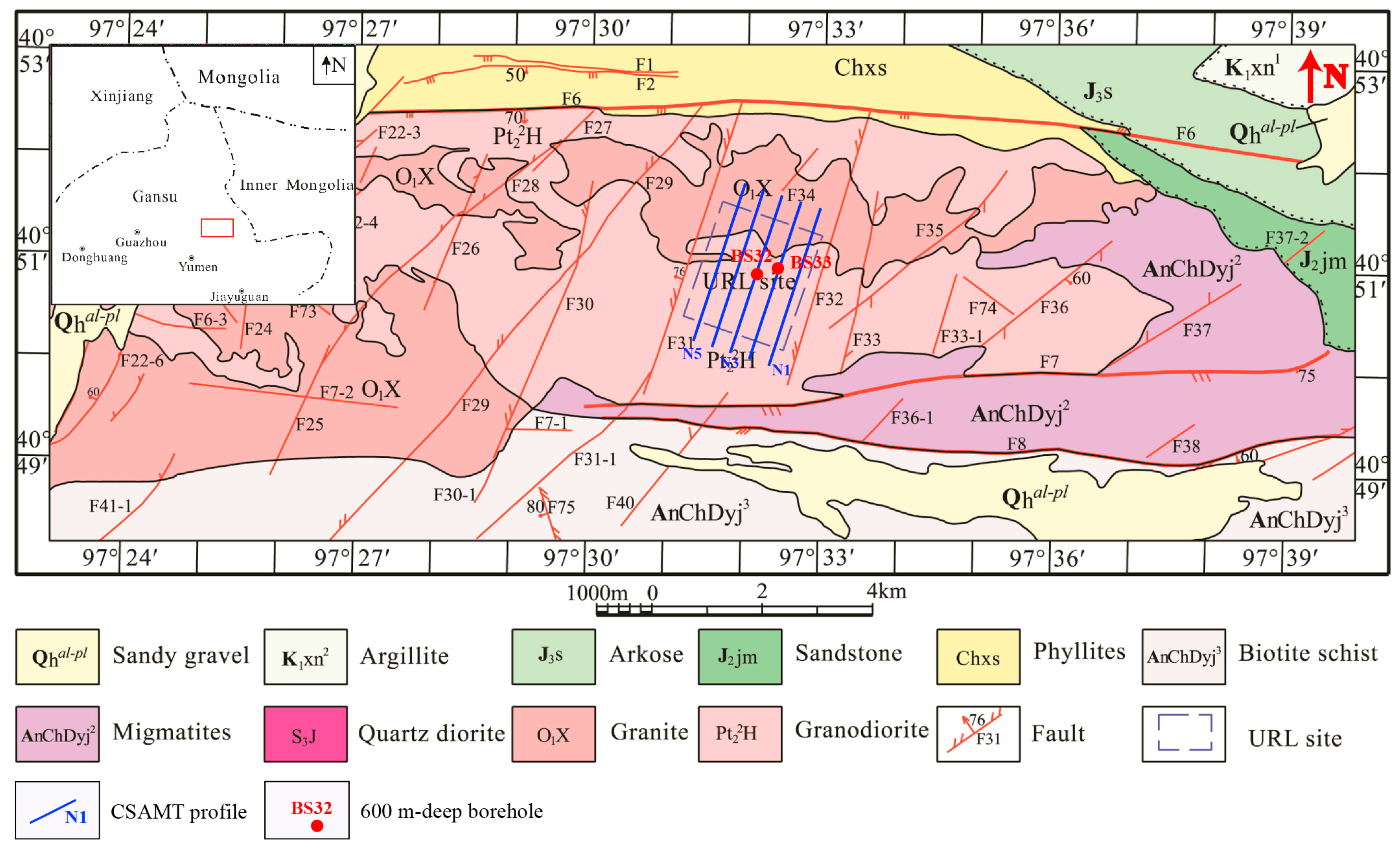
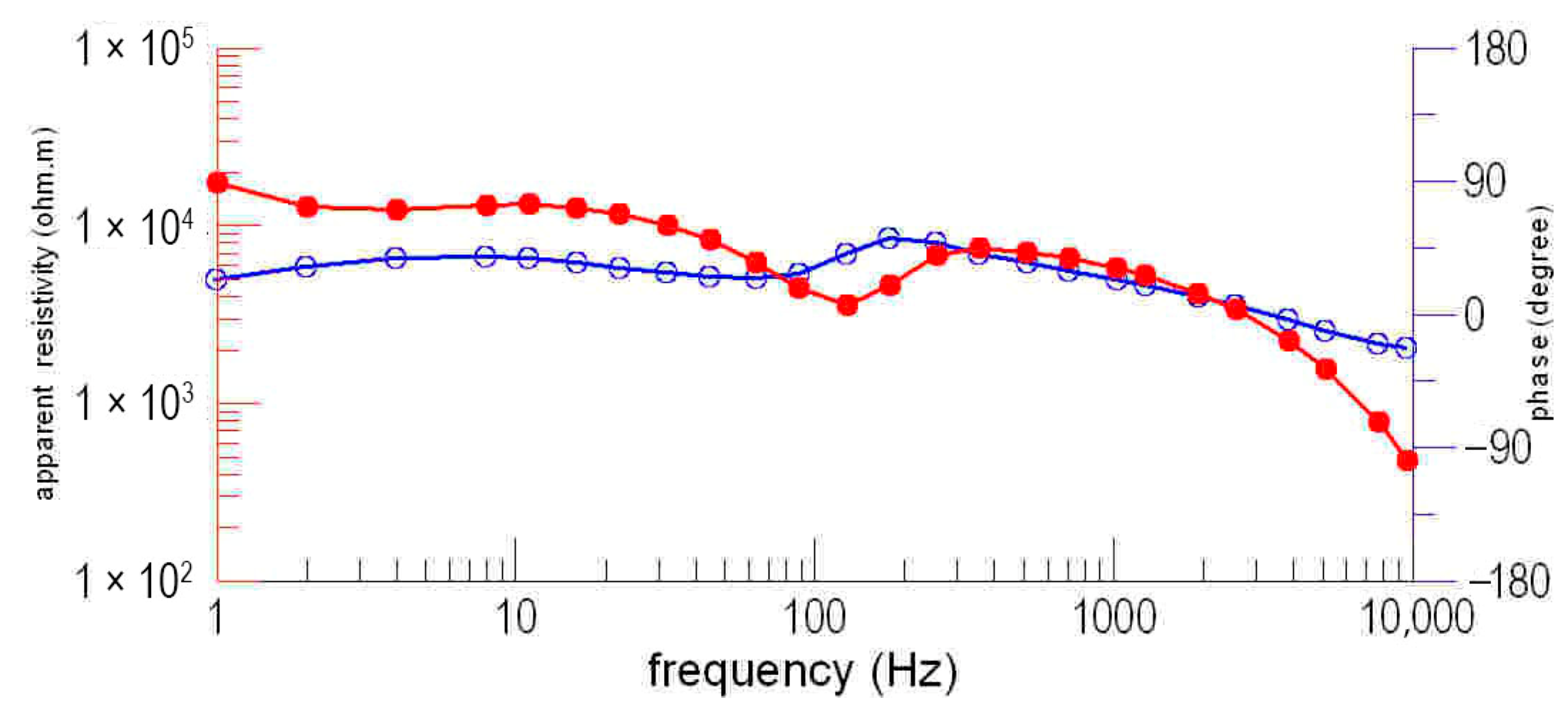
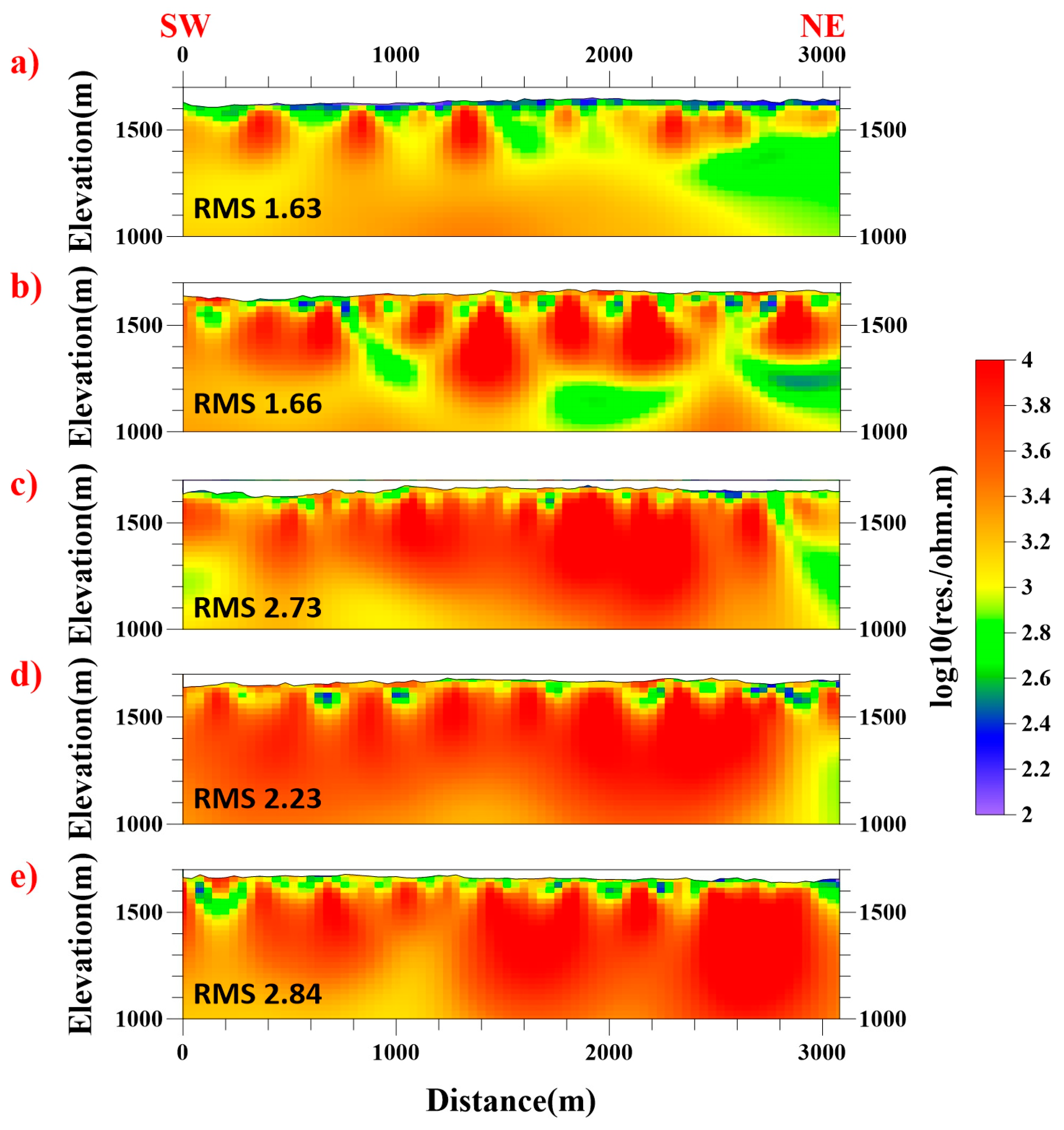
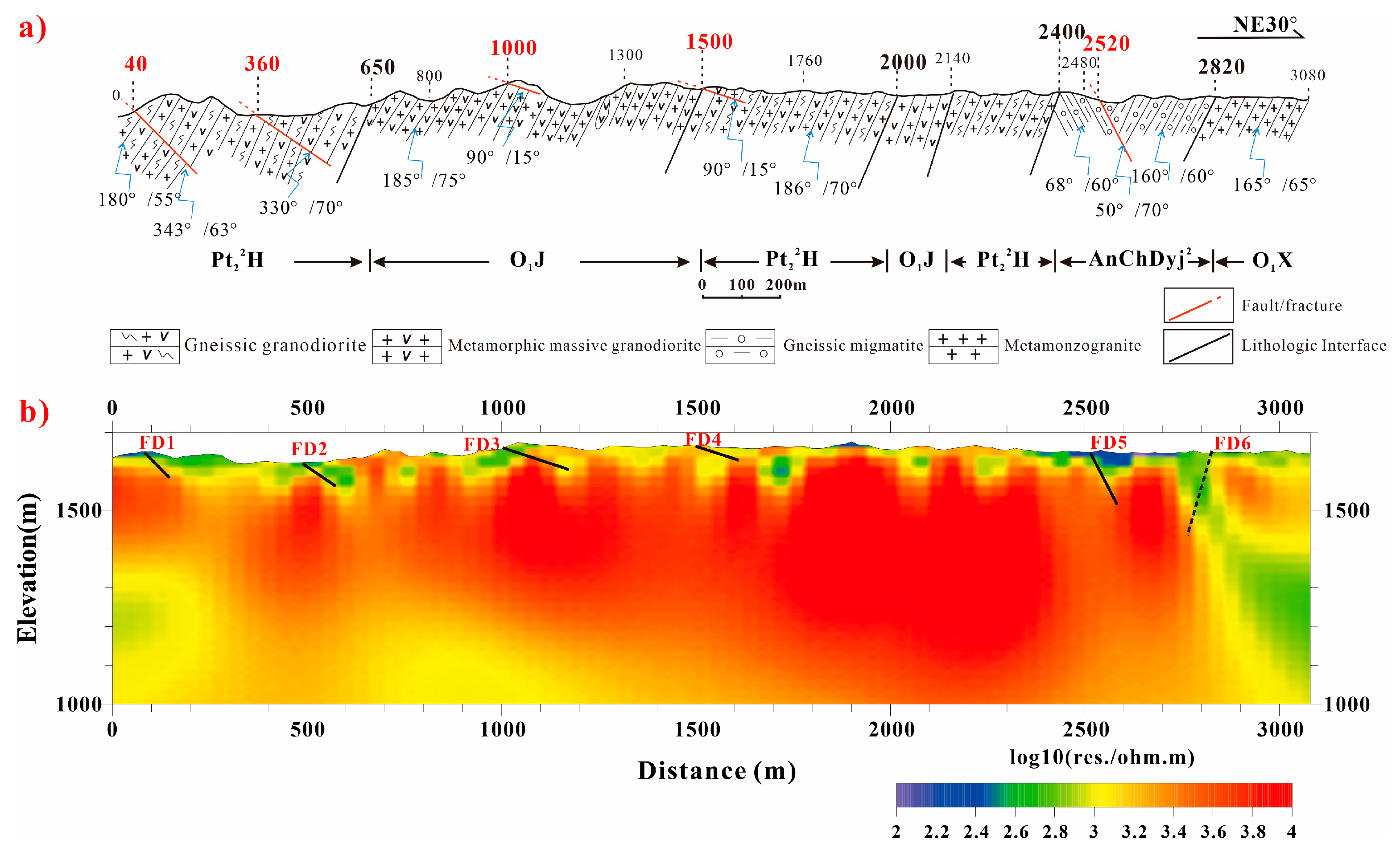
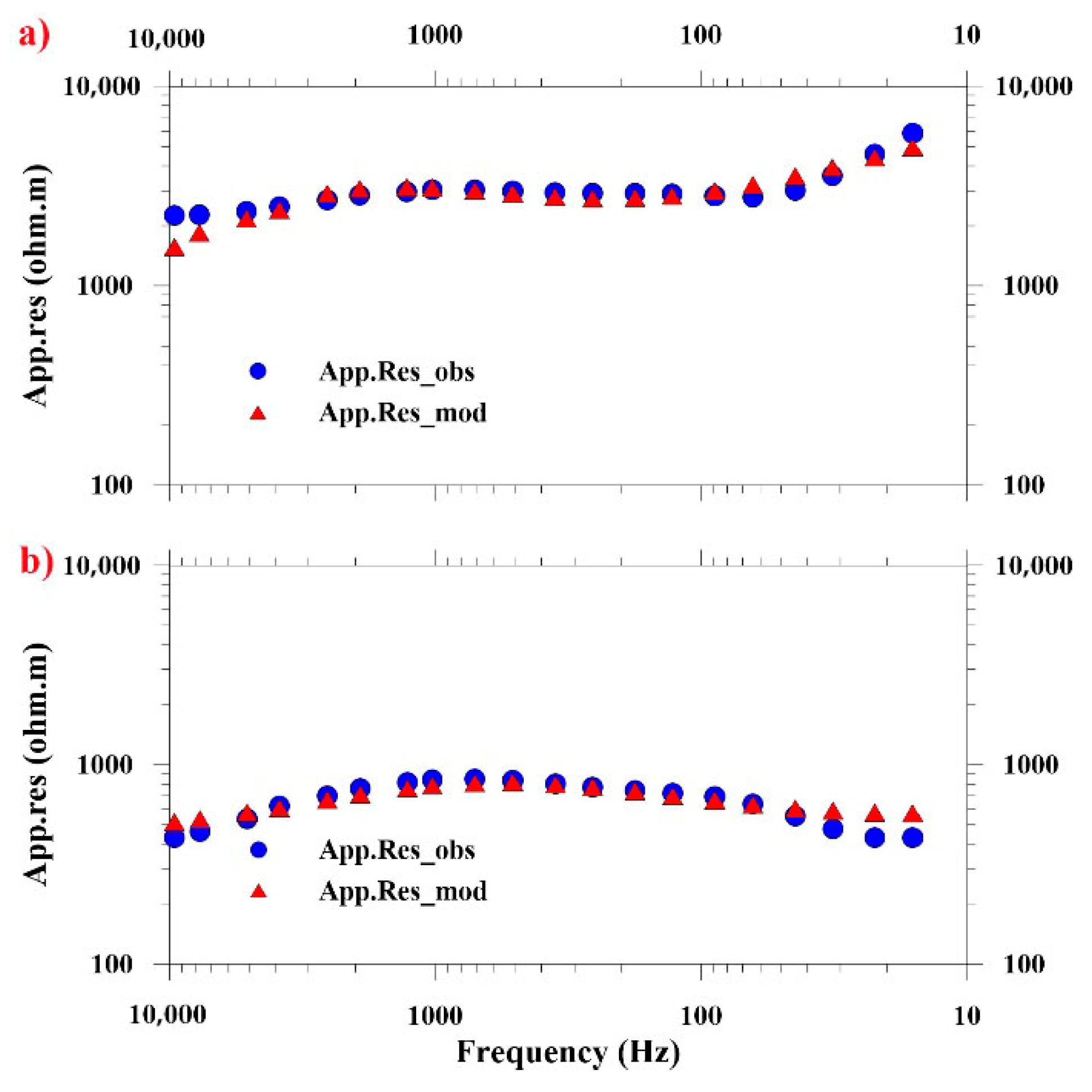
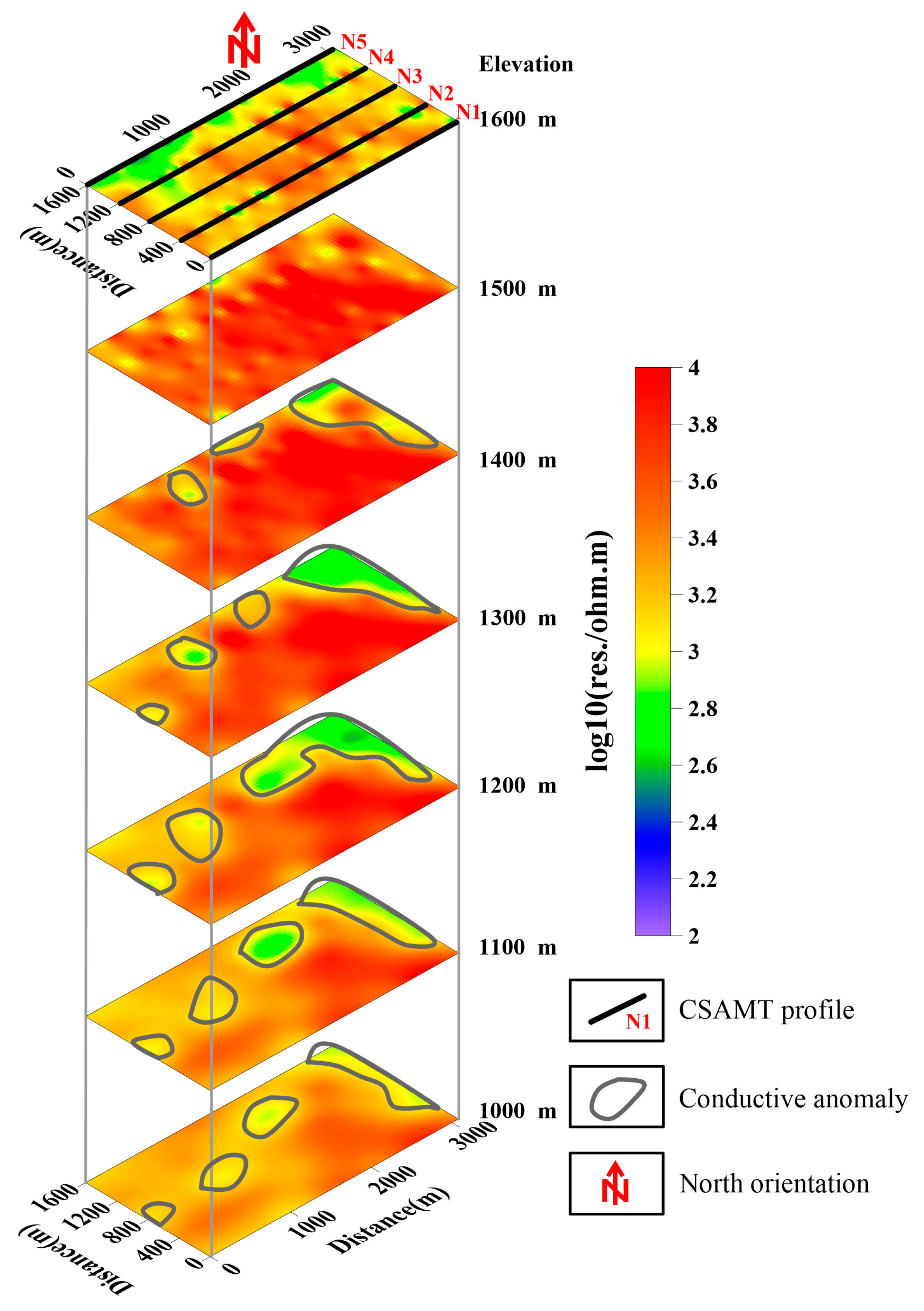
| Lithology | Average Resistivity (ohm·m) |
|---|---|
| Diabase | 2197 |
| Massive granodiorite | 12,206 |
| Fine-grain granite | 9679 |
| Diorite porphyrite | 9860 |
| Medium- to fine-grain gneissic granodiorite | 2622 |
| Medium- to fine-grain granodiorite | 6957 |
| Migmatite | 5060 |
Disclaimer/Publisher’s Note: The statements, opinions and data contained in all publications are solely those of the individual author(s) and contributor(s) and not of MDPI and/or the editor(s). MDPI and/or the editor(s) disclaim responsibility for any injury to people or property resulting from any ideas, methods, instructions or products referred to in the content. |
© 2025 by the authors. Licensee MDPI, Basel, Switzerland. This article is an open access article distributed under the terms and conditions of the Creative Commons Attribution (CC BY) license (https://creativecommons.org/licenses/by/4.0/).
Share and Cite
An, Z.; Di, Q.; Fu, C.; Wang, Z. CSAMT-Driven Feasibility Assessment of Beishan Underground Research Laboratory. Sensors 2025, 25, 4282. https://doi.org/10.3390/s25144282
An Z, Di Q, Fu C, Wang Z. CSAMT-Driven Feasibility Assessment of Beishan Underground Research Laboratory. Sensors. 2025; 25(14):4282. https://doi.org/10.3390/s25144282
Chicago/Turabian StyleAn, Zhiguo, Qingyun Di, Changmin Fu, and Zhongxing Wang. 2025. "CSAMT-Driven Feasibility Assessment of Beishan Underground Research Laboratory" Sensors 25, no. 14: 4282. https://doi.org/10.3390/s25144282
APA StyleAn, Z., Di, Q., Fu, C., & Wang, Z. (2025). CSAMT-Driven Feasibility Assessment of Beishan Underground Research Laboratory. Sensors, 25(14), 4282. https://doi.org/10.3390/s25144282






